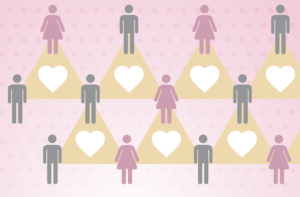Lots of Love: Exploring Polyamory in Portland

FROM HBO’s popular polygamist drama Big Love to Showtime’s two-season reality show Polyamory: Married & Dating, tales of copulating outside of coupledom offer a titillating yet often forbidden universe—an apple left unbitten on the tree of lust.
For those unfamiliar with the term “polyamory,” author and expert Franklin Veaux notes that it’s based on the Greek and Latin for many (poly) loves (amor). A polyamorous person, he says, “is someone who has or is open to having more than one romantic relationship at a time, with the knowledge and consent of all their partners.” A polyamorous relationship is one in which all parties agree that it’s okay to have other romantic partners or be open to that possibility.
Writing at Psychology Today in 2014, Elisabeth Sheff, PhD, who has done extensive research on polyamorous families with children, estimates that some 9.8 million adults in the United States practice some form of polyamory. However, because non-monogamy isn’t listed as an option on the US Census or other demographic surveys, it’s hard to verify. Also, given the stigma associated with alternative lifestyles, people who are in non-monogamous relationships often choose to keep their relationship status private. Hence, one can surmise that the actual number of adults engaged in some form of non-monogamy is, in all likelihood, higher.
In his BBC documentary sereis, Altered States, Louis Theroux applies his immersive style of filmmaking to this seemingly forbidden topic of polyamory in an episode called “Love Without Limits.” In this quest, Theroux set his sights on Portland, Oregon, a city deemed the kinkiest city in the United States by Kink University (an online resource for porn and information and workshops on alternative sexuality). Intimacy educator and sex coach Stella Harris points to Portland’s liberal climate and “laid back outlook on sex and sexuality” as attributes that allow such communities to thrive and why Portland is an ideal setting for exploring this topic.
Here, one will find an overabundance of strip clubs, sex clubs, meetup groups, and sex-positive performance art. Take, for instance, Eleanor O’Brien, who founded Dance Naked Productions in Portland over ten years ago to celebrate the joys of sexuality through theater. This past year O’Brien hosted the Come Inside theater festival for two weeks in October, offering a collection of sex-positive performances from across the spectrum of sexual orientations, gender identities, and relationship configurations. One entry, titled Sexology: The Musical, is a lyrical romp about a seemingly typical American girl’s discovery of her bisexuality and later realization that loving many people feeds her creative soul.
Humanists can lead on expanding opinions of ethical non-monogamy beyond the coupled binary that so far seems to dominate portrayals of polyamory.
Given these various celebratory offerings, one would expect Theroux’s documentary to cover the city’s cornucopia of sexual sights and sounds and offer an interactive education in the expansive possibilities of relationship configurations. But such an exploration into Portland’s bounty of sexual riches come up short.
Instead, Theroux interviewed a smattering of couples whose conversations about their relationships sounded like they were lifted from an episode of Portlandia (the IFC comedy series that pokes fun at the city and its denizens’ quirks). Bypassing any examination of a successful relationship where all parties were able to satisfy their sexual needs, Theroux focused on couples where at least one person felt “left out” of the open relationship. The host’s anxiety regarding the perceived dangers of what opening up could do to his own monogamous marriage seemed to cause him to zoom in on partners who didn’t fully consent to opening up their relationship. This undue focus on polyamory’s pitfalls deprived the viewer of learning about the fuller range of sexual expressions that abound both in Portland and elsewhere.
Susan Cohn, a Reiki master who curates sensual touch events, spoke to me about why she chose to participate in the blindfolded sensual dinner featured in the BBC documentary. “I enjoy opening people up to the mystery of a fuller sensual experience with themselves. The healthy curiosity of BBC excited my interest in supporting them through a positive consensual experience.” Incidentally, this dinner represented a healthy form of open relationships, though the filming focused more on the salacious aspects which led some reviews to miscategorize it as an orgy.
Reached via email, Cliff Rees, host of this dinner, agrees that “Love Without Limits” focused on the unhealthy aspects of polyamorous relationships. “I wish he hadn’t only highlighted relationships with serious problems, as that makes people think that open relationships are guaranteed disasters,” Rees says. “In my experience, poly/open relationships have no higher percentage of problems and hurt feelings than monogamous ones.”
 By focusing primarily on polyamorous people who are married or in committed partnerships, the documentary also leaves viewers with the mistaken impression that polyamory is limited to couples wherein one of them wishes to have sex with at least one additional person besides their primary partner. In reality, one can find a wide array of relationship styles. Some people are single and poly. Some practice “polyfidelity,” a term used to describe a closed set of relationships whereby a group of individuals, be it a triad, quad, or more, agree to be sexually exclusive within this relationship system. Some people have a central primary relationship with other relationships deemed secondary. In this vein, some committed couples seek out sexual play via swinging, and many of them reject the label of polyamory. Other people prefer a less hierarchical model, perhaps choosing to view all partners as equal. A growing number of individuals call themselves “relationship anarchists” and refuse to define any of their romantic interactions.
By focusing primarily on polyamorous people who are married or in committed partnerships, the documentary also leaves viewers with the mistaken impression that polyamory is limited to couples wherein one of them wishes to have sex with at least one additional person besides their primary partner. In reality, one can find a wide array of relationship styles. Some people are single and poly. Some practice “polyfidelity,” a term used to describe a closed set of relationships whereby a group of individuals, be it a triad, quad, or more, agree to be sexually exclusive within this relationship system. Some people have a central primary relationship with other relationships deemed secondary. In this vein, some committed couples seek out sexual play via swinging, and many of them reject the label of polyamory. Other people prefer a less hierarchical model, perhaps choosing to view all partners as equal. A growing number of individuals call themselves “relationship anarchists” and refuse to define any of their romantic interactions.
In the documentary, Rees and his two female partners are shown briefly with Theroux in a hot tub, though their interview was left on the cutting room floor. Had that conversation been included, viewers would have learned about how these three single adults function in what they term a triad. Rees explains their relationship dynamic: “All three of us deeply enjoy and spend most of our time with each other, yet all three of us have sexual relationships with people outside our triad. What makes it work for me is a solid sense of self, excellent communication skills, plus deep trust in the integrity and emotional stability of both of my partners.”
As Rees notes, “There are a number of organizations that offer both educational classes and support for people interested in exploring relationship possibilities outside what Christopher Ryan, co-author of Sex at Dawn, calls ‘the standard narrative.’” Rees himself is a graduate of Alan Lowen’s “Body, Heart & Soul” training and has been teaching meditation and tantra courses for over twenty years, both globally and in Portland through organizations like Sex Positive Portland.
For those who find the concept of polyamory completely foreign, the aforementioned Sex at Dawn is a foundational work for those interested in unpacking the prehistoric roots of polyamory. The Ethical Slut: A Practical Guide to Polyamory, Open Relationships & Other Freedoms in Sex and Love by Janet W. Hardy and Dossie Easton, as well as Franklin Veaux and Eve Rickert’s More Than Two: A Practical Guide to Ethical Polygamy, are two of the top resource books in the field of alternative sexualities. And of course there are myriad therapists, sex educators, and other professionals working with those seeking alternatives to traditional monogamy.
As a clinical sexologist, Dr. Kelly Rees (who was formerly married to Cliff Rees), focuses on helping individuals and couples from various orientations, gender expressions, and socioeconomic levels find satisfying ways to express their sexuality and discover intimate connection with others. In an email exchange, she defines healthy open relationships as those in which “all parties are interested in relating to others emotionally and sexually and willing to put in the work that it takes to be considerate of all involved.” In hierarchical non-monogamy, she says, “all are willing to pass on opportunity for the benefit of the primary relationship. Each person has a grasp of themselves as their own sexual entity.” Conversely, she finds that unhealthy open relationships are based on secrecy, manipulation, attempts to please or appease one partner, last-ditch efforts to stay together, and judgement about the other’s choices, rather than on connection, pleasure, and expansion.
Professionals who work with those looking to open up their relationships recommend that before taking that first step, couples need to be certain that they are in a solid place with each other and with themselves, and that they can move through the process in a way that feels good for both of them. When a monogamous couple explores “opening up,” as the shift to polyamory is sometimes called, certain factors will surface, notes Portland-based psychotherapist and relationship coach Gwenn Cody. “The underlying health of the relationship’s attachment, communication skills, core-values alignment, groundedness, and resiliency are going to be revealed. Buried resentments and conflicts about intimacy and sexuality can show up unexpectedly, as can hidden compulsions and fixations.”
During the blindfolded sensual dinner featured in Theroux’s “Love Without Limits,” Cliff Rees warns: “Thinking that polyamory is going to fix your relationship is absolutely doomed to failure.” When asked to expound on this comment, he says,
If a relationship is co-dependent with frequent conflicts, opening it up is only going to greatly increase anxiety and the potential for jealousy for at least one participant, and probably for all. Relating well with just one person is a serious challenge—relating well to many takes far more skill, yet can be far more rewarding.
Stella Harris, the intimacy educator quoted earlier who engages in open relationships herself and teaches classes on everything from communication to group sex, notes that “open relationships of any flavor can be wonderful, but they’re not for everyone.” She also rejects the idea that open relationships are somehow more evolved.
Everyone needs to be free to choose the relationship style that works for them. The trick is making your choice with full knowledge of what the options are, as well as freedom to choose without repercussions or coercion. Whatever style you choose (even monogamy) it’s important to clearly negotiate with your partner around what that means for both of you.
Harris recommends that individuals look carefully at the ethics of any situation they’re creating or joining. “All too often people end up treated like things, or as a means to an end,” she says. “If you’re interested in these relationship styles, do your reading and research so you have a strong basis to negotiate from.”
 Cliff Rees points to the practical difficulties of exploring ethical non-monogamy: “Legally, the issue of divorce, alimony, child custody and support, and ownership of property is going to be quite complex if the ethical non-monogamy involves more than just a primary couple and an occasional secondary.” Who pays for what, who supports whom and for how long, who decides on children’s medical treatment and education of children—these are all considerations. Ultimately, Rees thinks relationship contracts (he suggests covering five years) are needed to sort out those issues in advance.
Cliff Rees points to the practical difficulties of exploring ethical non-monogamy: “Legally, the issue of divorce, alimony, child custody and support, and ownership of property is going to be quite complex if the ethical non-monogamy involves more than just a primary couple and an occasional secondary.” Who pays for what, who supports whom and for how long, who decides on children’s medical treatment and education of children—these are all considerations. Ultimately, Rees thinks relationship contracts (he suggests covering five years) are needed to sort out those issues in advance.
In her work as a therapist, Cody finds that by guiding clients to go deeper into their sexuality, they can move from viewing sex as a transaction into exploring how their sexuality functions on multiple levels. These range from the more animalistic and pleasure-focused, which Cody notes can have quite positive expressions, to the most subtle levels of union with another human being. “The ability to know who you are on those different levels, have access to those different levels inside yourself, and have boundaries to take care of yourself around all those levels is very important.”
Through this self-exploration, Cody hopes people can perceive how there are many “colors” to a relationship where they previously only saw a few. “When this exploration goes well, it tends to create more self-determination for each individual by giving them more nuance and understanding in what they want from any of their relationships. The more you can own your sexuality in all of its aspects, the better decisions you can make about who you open up to and how you open up.”
“All three of us deeply enjoy and spend most of our time with each other, yet all three of us have sexual relationships with people outside our triad.”
It’s important to note that society as a whole still imposes restrictions on individual sexuality, and religious dogma in particular has a lot to say about what’s right and wrong concerning sex. Dr. Charity Benham, a clinical psychiatrist and one of Cliff Rees’ partners, observes that even progressive Christians are highly influenced by the rhetoric of their communities:
This is particularly true if said Christian is being funded by an organization in the larger Christian community. Unfortunately, even Christians with sex-positive values are often internally and externally pressured to hold to a monogamy-centric worldview.
Take, for instance, a progressive denomination like the US Episcopal Church that has canon laws prohibiting discrimination on the basis of sexual orientation, gender identity, or expression, as well as a liturgy for same-sex marriages and yet doesn’t advocate for the rights of those who practice ethical non-monogamy.
In her experience, Benham found she was unable to truly embrace her sexual desires until she went through her apostasy, which was a long process beginning in her mid-twenties. “I feared being ‘out’ as poly, kinky, and pansexual because I wasn’t ‘out’ as a humanist, and my business as a health practitioner depended on continued clients from the religious community,” she recalls. “The shadow of purity culture is far-reaching.”
Moving forward, humanists, who aren’t coddled by religiously imposed rules about sex, could be at the forefront of this discussion. Even for those who don’t practice polyamory, a key tenet of humanism is about autonomy and personal expression, encouraging healthy, ethical, and empathetic approaches to enable each person to live out their authentic lives. Humanists can lead on expanding opinions of ethical non-monogamy beyond the coupled binary that so far seems to dominate portrayals of polyamory. The apple is ripe for picking and our bite can be big, encompassing and encouraging a diversity of relationship styles and alternative sexualities.
